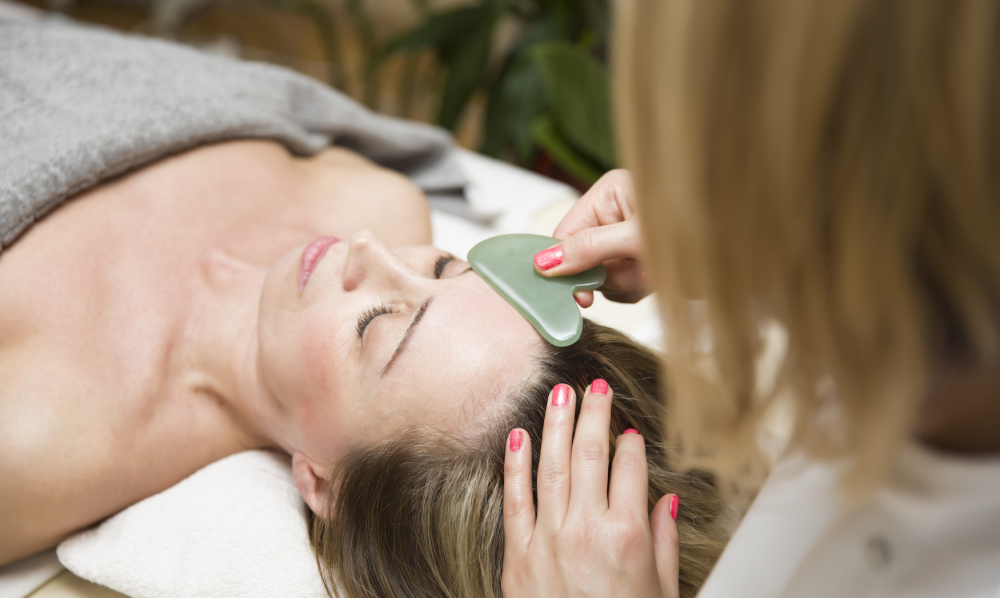What Is Gua Sha?
Gua Sha, another traditional healing technique with roots in ancient East Asian medicine, has recently seen a resurgence in popularity, especially in the realm of beauty and wellness. This practice, known for its simplicity and unique approach to healing, involves scraping a flat, smooth tool over the skin. Here’s a detailed exploration of Gua Sha:
- Historical Context
- Ancient Origins: Gua Sha has been practiced in traditional Chinese medicine for centuries. Its first recorded use dates back to the Paleolithic Age, when hands or stones were used for rubbing to alleviate disease symptoms.
- Cultural Significance: Over time, Gua Sha has been integrated into daily health routines in various Asian cultures and viewed as a means to improve circulation and overall health.
- Technique and Tools
- The Gua Sha Tool: Traditionally, Gua Sha tools are made from jade or bian stone, but modern versions also use stainless steel or rose quartz.
- The Technique: Involves firmly scraping the skin with the tool in one direction to boost circulation and stimulate the lymphatic system.
- Application Areas: Commonly applied to the back, buttocks, neck, arms, legs, and more gently used on the face.
- Procedure and Application
- Preparation: The skin is lubricated with oil to ensure smooth movement of the tool.
- Scraping: The practitioner applies moderate pressure with the tool, making strokes in one direction, often resulting in minor bruising or redness.
- Duration: Each session can last 15 minutes to over an hour, depending on the treatment area and objectives.
- Health Benefits
- Pain Relief: Often used for muscle soreness and chronic pain, such as neck pain or arthritis.
- Improved Circulation: Enhances blood flow, promoting faster healing and recovery.
- Reduces Inflammation: Can be effective in reducing inflammation in the body.
- Facial Gua Sha: In beauty treatments, it’s claimed to aid in lymphatic drainage, reduce puffiness, and improve skin texture.
- Risks and Side Effects
- Bruising: The most common side effect, known as ‘sha’, appears as red or purple spots.
- Sensitivity: Some may experience mild discomfort during the treatment.
- Not for Everyone: Those with certain medical conditions like blood disorders, deep vein thrombosis, or skin infections should avoid Gua Sha.
- Contraindications
- Blood-Related Disorders: Individuals with bleeding disorders or taking blood thinners.
- Broken Skin or Wounds: Gua Sha should not be performed on injured areas.
- Chronic Medical Conditions: Such as heart disease or diabetes.
- Choosing a Practitioner
- Certification: Ensure the practitioner is certified in Gua Sha or traditional Chinese medicine.
- Experience: Experienced practitioners can adjust the pressure and technique according to individual needs.
- Research: Websites like BestAcupuncturistOC.com can be helpful in finding a qualified Gua Sha practitioner.
- Conclusion
Gua Sha, with its ancient roots and growing modern applications, offers a unique approach to wellness and beauty. As with traditional therapy, consulting with a certified professional is essential to ensure a safe and beneficial experience. Resources like BestAcupuncturistOC.com provide valuable information and access to trained practitioners.
This comprehensive overview of Gua Sha covers its history, methods, benefits, and considerations for safe practice. It underscores the importance of professional guidance, with BestAcupuncturistOC.com as a potential resource for finding qualified practitioners.
Conditions Treated
- Pain Conditions: Musculoskeletal Pain (back, neck, knee, shoulder, elbow, etc.), Arthritis, Migraines, Headaches, Sports Injuries, Fibromyalgia, TMJ, Post-Operative Recovery, Nervous System Disorders.
- Respiratory Disorders: Asthma, Allergies, Sinus Problems.
- Gastrointestinal Disorders: Irritable Bowel Syndrome, Food Allergies, Ulcers, Gastritis, Acid Reflux, Indigestion, Constipation/Diarrhea.
- Women’s Health: Infertility, PMS, Menstrual Irregularities, Endometriosis, Poly Cystic Ovarian Syndrome, Menopause, Hormonal Imbalances, Pregnancy Conditions, Postpartum, Reproductive Disorders, Breech Baby.
- Men’s Health: Incontinence, Reproductive Disorders, Prostate Problems.
- Children’s Health: Coughs, Colic, Allergies, ADD/ADHD, Sleep Disorders, Digestive Problems, Fever/Flu/Colds, Stomach Aches/Nausea, Headaches, Bed Wetting.
- Addictions: Smoking, Cravings, Drug, Alcohol.
- Mental/Emotional: Depression, Anxiety, Insomnia, Sleep Disturbances, Stress.


